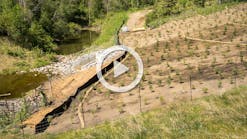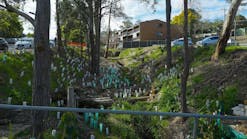‘Reefense’ restoration project: Developing hybrid reefs to reduce wave energy and shield coastal communities
July 18, 2023
Coastal resilience is a key concern and a top priority for communities across the United States — especially along the Gulf Coast, where hurricanes are common, inland flooding and erosion occur with more frequency, and storm surge often wreaks catastrophic damage.
These factors, combined with sea level rise, are accelerating erosion along the coast, putting critical infrastructure at risk and opening the door to more frequent and damaging storm events.
Research is under way to develop self-healing, hybrid biological and engineered reef-mimicking structures that address some of the challenges brought forth by a rapidly changing climate. Funded by the Defense Advanced Research Projects Agency (DARPA), the research seeks effective solutions to protect both coastal civilian and military infrastructure, as well as impacted populations.
The project, “Reefense: A Mosaic Oyster Habitat for Coastal Defense” is being led by Rutgers University and has been well under way since May 2022.The U.S. Gulf Coast is one of three locations where research is being conducted within the wider DARPA Reefense program and is the only location focusing on the use of ecologically engineered oyster reefs.
Specific focus areas of the Reefense project include:
- Novel materials and reef design, which involves developing interlocking reef modules arranged to minimize wave energy reaching the shoreline;
- Micro-structural design components that encourage oyster recruitment and minimize predation to oysters from being eaten; and
- Selective breeding of native oysters shown to grow faster and be more resistant to disease.
WSP USA has been supporting the project since its inception. In addition to leading project permitting and managing the eventual reef construction, WSP is collaborating with the Reefense team on various experiments and working in bay waters off the Florida panhandle every two weeks to characterize the site and monitor seasonal changes.
These field activities are focused on three tasks:
- deploying and retrieving wave gauges and other sensors that collect key data from the project site.
- monitoring selectively bred native oysters to evaluate performance; and
- collecting native oysters under Florida Fish and Wildlife Conservation Commission special activity license number SAL-22-2391-SR), which are shipped to Rutgers for disease testing.
This specific information is being compiled to provide an accurate view of existing site conditions over time. It will be used to compare before-and-after measurements once the engineered reefs are installed to evaluate success.
Mosaic Habitats
The goal is to create a mosaic habitat, which can support multiple species in an area that promotes a self-sustaining oyster population and helps diminish wave intensity to protect U.S shorelines. The magnitude of wave attenuation is governed by physical characteristics, like water depth, reef crest elevation and overall structure width and depth, which are often used to design non-living wave-breaking structures.
“This is part of what makes the modular design so important, since the overall structure is adaptable to different conditions,” said Nigel Temple, a University of South Alabama professor and a coastal restoration specialist with WSP. Temple is the firm’s main liaison with the project and research team.
In locations where wave attenuation is less important, Temple said the modular design will help protect against erosion from daily currents
while providing additional habitat value.
“Our partners in Australia have built and tested modules in a wave flume using multiple configurations and a variety of conditions,” he said. “Overall, those tests showed that various configurations could meet Phase II and III target wave attenuation goals of 70% and 90%, respectively.”
General configuration and stability in the field is currently being investigated in models by the same partners.
Why Oysters?
The environmental benefits of oysters and oyster reefs are long known and well-documented. In addition to providing critical habitat for hundreds of marine species, oyster reefs play a key role in maintaining an ocean’s health. Oysters feed on algae, so they also serve as nature’s filter to improve waters that are overloaded with nutrients. The National Oceanic and Atmospheric Administration says a single oyster can filter up to 50 gallons of water per day.
Both oyster reefs and coral reefs offer similar attributes in that they provide critical habitat and improve water quality.
The biggest difference is that coral reefs are only subtidal, meaning they are always submerged, whereas oyster reefs can also thrive intertidally, fluctuating between land and sea, depending on high tide and low tide conditions.
Breeding and Testing
More than 150 varieties of oysters are harvested across North America, yet they include only five different species. It is estimated that 70% of the oysters produced in the United States come from the Gulf of Mexico, which is home to the eastern oyster (Crassostrea virginica).
One of the primary goals of this Reefense project is to design a low-cost reef that can house oysters that are more resilient to disease. Finding those oysters is where teams of researchers at Auburn University and Louisiana State University (LSU) are involved. They are working alongside the Rutgers team to breed oysters through phenotypic and genomic selection for faster growth and tolerance to dermo disease (Perkinsus marinus).
Auburn’s role is to manage the actual spawning and rearing of the oysters, maintain broodstock, and field test the resulting offspring, while LSU’s principal focus is to challenge those oysters with dermo disease, as part of the selection process that is led by Rutgers, which has the longest running oyster breeding program in the world.
“Past attempts to decrease the susceptibility of eastern oysters to dermo disease, using traditional phenotypic selection have not been very successful,” said Jerome La Peyre, professor in LSU’s School of Animal Sciences.
The hope of these teams is that adding genomic selection to the process will yield better results.
“This work is in line with a lot of our goals to breed better oysters for restoration and aquaculture,” said Scott Rikard, manager of Agricultural and Natural Resources Programs at Auburn’s Shellfish Laboratory.
Oyster lines that make it through the dermo disease testing are field tested at one of three locations: Grand Isle, Louisiana; Grand Bay,
Alabama; or St. Andrews Bay, Florida.
A Five-Year Project Involving a Lot of Collaboration
The Gulf portion of the Reefense project officially kicked off in May 2022 and includes three phases. The first two phases are each set to be 18 months in duration, followed by a final phase that will last two years. It is a big project that includes a lot of partners, so various teams are leading individual efforts.
Additional participants in this DARPA project include Rutgers University, Mississippi State University, Louisiana State University, Auburn University, the University of Arizona, the University of Central Florida, the University of Melbourne, the University of Western Australia, Reef Design Lab and the Partnership for Delaware Estuary.
WSP has been involved in a variety of coastal restoration projects using engineered oyster reefs, including the Franklin-98 Living Shoreline, where 20 acres of oyster reef and 30 acres of saltmarsh are being created to repair eroded areas of the Apalachicola Bay shoreline along Highway 98 in Franklin County, Florida. WSP also is monitoring the development of oyster reefs in Pensacola Bay, Florida, and supported the Living Breakwaters project off the coast of Staten Island, New York.
About the Author
Kathleen Saal
Kathleen Saal is a member of the communications team for WSP. Saal can be reached at [email protected].







